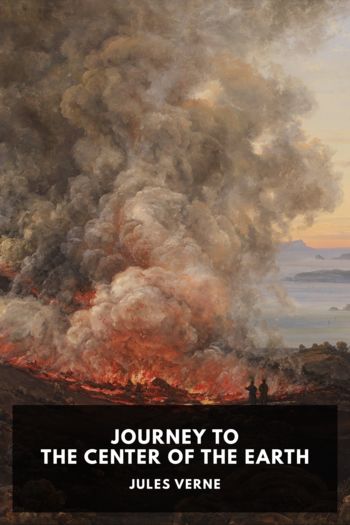Topsy-Turvy by Jules Verne (best book recommendations .txt) 📕

- Author: Jules Verne
Book online «Topsy-Turvy by Jules Verne (best book recommendations .txt) 📕». Author Jules Verne
Evidently this shaft of a mine, this enormous elongated mine, could replace a metal cannon the fabrication of which would have been as dear as difficult and to which it would be necessary to give an unwieldy thickness to avoid all risk of an explosion. Barbicane & Co. had always entertained the idea of operating in this manner, and if the notebook of J. T. Maston mentioned a cannon it was that of 27 centimetres which had been used in the calculations as a basis. Consequently a spot was chosen at a height of a hundred feet on the southern slope of the chain. Nothing would be in the way of the projectile when it would fly out of the mouth of this tunnel bored in the massive rock of Kilimanjaro. It was with extreme precision and not without very hard work that the men could dig this gallery. But Barbicane & Co. could readily make perforations with simple machines put in action by means of compressed air which was secured by using the powerful falls of water from the mountains. In the holes bored through the headings of the shaft were placed charges of melimelonite. And nothing more was necessary than this violent explosive to shiver the rock, extremely hard as it was.
The thousands of workmen, led by their ten cooperators under the general direction of Barbicane & Co., labored with a great deal of zeal and intelligence to bring the work to a speedy end. At the end of six months the shaft measured 27 metres in diameter and the lining of it 6 metres in thickness. As it was absolutely necessary that the projectile should glide through a bore perfectly smooth the interior of it was covered with a casting exactly prepared. In reality this part of the work was very similar to that of the celebrated Columbiad, of Moon City, which had sent the projectile to the moon. But such work as this is impossible to the ordinary engineers of this world at present.
As soon as the boring was finished the workmen pushed on with the work at the second workshop.
At the same time that this metallic lining was being made they were also employed at making the enormous projectile. For this operation it was necessary to obtain a cylindrical mass which would weigh 80,000,000 kilograms, or 180,000 tons. It must be understood that there was never any idea of melting this projectile in one single piece. It had to be manufactured in thousand-ton pieces, which would be hoisted one after the other into the shaft and put in place over the chamber where the melimelonite was stored. After having been jointed each to the other, these pieces would form a compact whole, which would fit the sides of the tubular lining. In regard to the construction of the massive furnaces to effect the melting of the metal, there was met perhaps the greatest difficulty. Ten furnaces of ten metres each in height were at the end of a month in working order and able to produce each 180 tons per day. This would be 1,800 tons for twenty-four hours—180,000 tons after 100 workdays.
In regard to the third workshop, made for the manufacture of the melimelonite, the work was easily done, but under such secret precautions, that the composition of this explosive it has not been possible to state perfectly. Everything went along splendidly. It could not have been possible to have met with more success in any factory. One would hardly expect to escape an accident of some sort on a three-hundred-thousand franc job. It is easily understood that the Sultan was delighted. He followed the operation with indefatigable interest. And the presence of His Majesty helped greatly to make these Negroes work as hard as possible. One day Bali-Bali asked what all these operations were going on for. He received his reply from President Barbicane: “It is a work,” said he, “which will change the face of the earth—a work which will bring the greatest glory on the greatest Sultan of all the Eastern kings.”
By the 29th of August the works were entirely finished.
The shaft was bored to the wished-for point. It was provided with a smooth bore of six metres diameter. At the bottom of the shaft were placed the 2,000 tons of melimelonite; then came the projectile 105 metres long. After deducting the space occupied by the powder and projectile there remained still 492 metres before the muzzle was reached, which secured all the effect possible by the recoil produced by the expansion of the gas.
Now, the first question which might come up was, would the projectile deviate from the trajectory assigned to it by the calculations of J. T. Maston? In no way, for the calculations were absolutely correct. They indicated to what extent the projectile would deviate to the east of the meridian of Kilimanjaro because of the rotation of the earth on its axis, and what would be the form of the curve which it would describe because of its enormous initial velocity. Secondly, would it be visible during its course? No, because in going out of the shaft it would be thrown in the shadow of the earth and it could not be seen, for in consequence of its low trajectory it would have a very sharp angle of velocity compared with the earth’s course. In fact, Barbicane and Capt. Nicholl could well be proud of their work, which had so far succeeded in its every detail. Why was J. T. Maston not there to watch this great operation, founded on the figuring which he had done? And who was it that kept him so far away, so very far, when this terrible detonation would wake the echoes as far as the furthermost horizon of Africa?
Thinking of him, his two associates did not know that the Secretary had been compelled to





Comments (0)